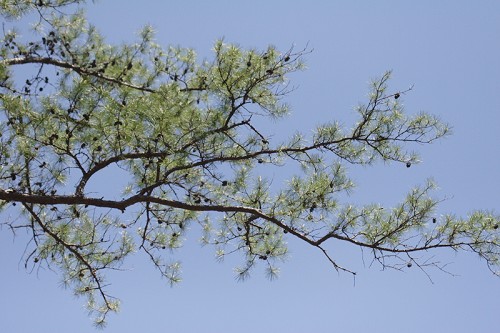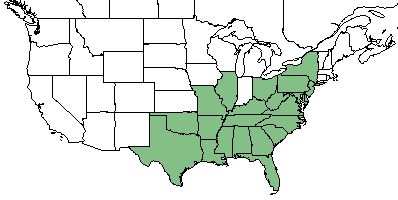Difference between revisions of "Pinus echinata"
(→Phenology) |
Juliec4335 (talk | contribs) (→Habitat) |
||
| Line 40: | Line 40: | ||
Specimens of the shortleaf pine have been collected from mixed woodland, open pine-oak second growth woods, upland mixed woods along rivers, long-leaf pine restoration sites, and decisuous woods <ref name = "FSU herbarium"> URL: http://herbarium.bio.fsu.edu. Last accessed: June 2018. Collectors: R.K. Godfrey, Richard S. Mitchell,Patricia Elliot, D. B. Ward, Loran C. Anderson, R. F. Doren, R. Komarek, William Platt. States and counties: Florida (Jackson, Okaloosa, Liberty, Leon, Jackson, Escambia, Gadsden, Santa Rosa, Madison, Wakulla, Grady), Georgia (Thomas)</ref> | Specimens of the shortleaf pine have been collected from mixed woodland, open pine-oak second growth woods, upland mixed woods along rivers, long-leaf pine restoration sites, and decisuous woods <ref name = "FSU herbarium"> URL: http://herbarium.bio.fsu.edu. Last accessed: June 2018. Collectors: R.K. Godfrey, Richard S. Mitchell,Patricia Elliot, D. B. Ward, Loran C. Anderson, R. F. Doren, R. Komarek, William Platt. States and counties: Florida (Jackson, Okaloosa, Liberty, Leon, Jackson, Escambia, Gadsden, Santa Rosa, Madison, Wakulla, Grady), Georgia (Thomas)</ref> | ||
<!--Natural communities, human disturbed habitats, topography, hydrology, soils, light, fire regime requirements for removal of competition, etc.--> | <!--Natural communities, human disturbed habitats, topography, hydrology, soils, light, fire regime requirements for removal of competition, etc.--> | ||
| + | |||
| + | ''Pinus echinata'' is frequent and abundant in the Clayhill Longleaf Woodlands community type as described in Carr et al. (2010).<ref>Carr, S.C., K.M. Robertson, and R.K. Peet. 2010. A vegetation classification of fire-dependent pinelands of Florida. Castanea 75:153-189.</ref> | ||
| + | |||
===Phenology=== | ===Phenology=== | ||
''P. echinata'' has been observed flowering in March. <ref name= "Pan Flora"> Nelson, G. PanFlora: Plant data for the eastern United States with emphasis on the Southeastern Coastal Plains, Florida, and the Florida Panhandle. www.gilnelson.com/PanFlora/ Accessed: 24 MAY 2018</ref> | ''P. echinata'' has been observed flowering in March. <ref name= "Pan Flora"> Nelson, G. PanFlora: Plant data for the eastern United States with emphasis on the Southeastern Coastal Plains, Florida, and the Florida Panhandle. www.gilnelson.com/PanFlora/ Accessed: 24 MAY 2018</ref> | ||
Revision as of 16:59, 21 July 2020
Common names: Shortleaf pine [1]
| Pinus echinata | |
|---|---|

| |
| Photo by John Gwaltney hosted at Southeastern Flora.com | |
| Scientific classification | |
| Kingdom: | Plantae |
| Division: | Magnoliophyta - Flowering plants |
| Class: | Magnoliopsida - Dicots |
| Order: | Pinales |
| Family: | Pinaceae |
| Genus: | Pinus |
| Species: | P. echinata |
| Binomial name | |
| Pinus echinata Mill. | |

| |
| Natural range of Pinus echinata from USDA NRCS Plants Database. | |
Contents
[hide]Taxonomic Notes
Synonym: P. mitis (michaux)
Variety: none
Description
P. echinata is a perennial tree of the Pinaceae family that is native to North America. [1]
Distribution
Native to the southeastern Unites States, p. echinata is found as far north as New York and as far west as Texas and Oklahoma. [1]
Ecology
Habitat
P. echinata has adapted to coarse, fina and medium textured soils. It has a medium drought tolerance. It has a high intolerance to shade.[1]
Ideal habitats include dry rocky ridges, slopes, sandhills, old fields, forests, and generally xeric sites but can occur in mesic to wet sites. [2]
Longleaf pine regions are ideal environments for the P. echinata of shortleaf pine, where they share a dominance over the area. [3] Much of these ecosystems thrive with winter burns, particularly in old-fields. [4]
Specimens of the shortleaf pine have been collected from mixed woodland, open pine-oak second growth woods, upland mixed woods along rivers, long-leaf pine restoration sites, and decisuous woods [5]
Pinus echinata is frequent and abundant in the Clayhill Longleaf Woodlands community type as described in Carr et al. (2010).[6]
Phenology
P. echinata has been observed flowering in March. [7]
Seedig begins in summer and will last through fall. [1]
Fire ecology
P. echinata has an extremely high tolerance for fire. [1]
Instances of fire or prescribed burning will promote regeneration of the shortleaf pine. [8]. COntinued prescribed burning in a region can make for ideal habitats for shortleaf pine forests instead of hardwoods being predominate in the region. [9] Shortleaf pines can provide habitats for the red-cockaded woodpecker; efforts at restoring the woodpeckers population in these environments include reintroduction of fire and constructing stands for the birds nesting. These prescribed burned shortleaf pine woods also provide a greater increase in small mammals in the region. [10]
Conservation and Management
Pinus echinata is considered endangered in Illinois[1]
Cultivation and restoration
Photo Gallery
References and notes
- ↑ Jump up to: 1.0 1.1 1.2 1.3 1.4 1.5 1.6 USDA Plant Database
- Jump up ↑ Weakley, A. S. (2015). Flora of the Southern and Mid-Atlantic States. Chapel Hill, NC, University of North Carolina Herbarium.
- Jump up ↑ Cipollini, M. L., et al. (2012). "Herbaceous plants and grasses in a mountain longleaf pine forest undergoing restoration: a survey and comparative study." Southeastern Naturalist 11: 637-668.
- Jump up ↑ Clewell, A. F. (2014). "Forest development 44 years after fire exclusion in formerly annually burned oldfield pine woodland, Florida." Castanea 79: 147-167.
- Jump up ↑ URL: http://herbarium.bio.fsu.edu. Last accessed: June 2018. Collectors: R.K. Godfrey, Richard S. Mitchell,Patricia Elliot, D. B. Ward, Loran C. Anderson, R. F. Doren, R. Komarek, William Platt. States and counties: Florida (Jackson, Okaloosa, Liberty, Leon, Jackson, Escambia, Gadsden, Santa Rosa, Madison, Wakulla, Grady), Georgia (Thomas)
- Jump up ↑ Carr, S.C., K.M. Robertson, and R.K. Peet. 2010. A vegetation classification of fire-dependent pinelands of Florida. Castanea 75:153-189.
- Jump up ↑ Nelson, G. PanFlora: Plant data for the eastern United States with emphasis on the Southeastern Coastal Plains, Florida, and the Florida Panhandle. www.gilnelson.com/PanFlora/ Accessed: 24 MAY 2018
- Jump up ↑ Elliott, K. J. and J. M. Vose (2005). "Effects of understory prescribed burning on shortleaf pine (Pinus echinata Mill.)/mixed-hardwood forests." Journal of the Torrey Botanical Society 132: 236-251.
- Jump up ↑ Garren, K. H. (1943). "Effects of fire on vegetation of the southeastern United States." Botanical Review 9(9): 617-654.
- Jump up ↑ The Role of Fire in Nongame Wildlife Management and Community Restoration: Traditional Uses and New Directions, Proceedings of a Special Workshop, 2000